Jana Johnson was a struggling grad student in 2003 when she first met the butterfly that would change her life.
She was 34, with two little boys and a crumbling marriage. Her research into the effect of wildfires on reptiles in the Santa Monica Mountains had stalled, she was juggling multiple part-time jobs, and her family was far away in Texas.
“I kept having this visual that I was hanging off a cliff, and my kids kept falling off the cliff, and I kept trying to fling them back up,” Johnson said.
Her therapist urged her to change her visualization. Pretend, he said, that you’re standing at the edge of the cliff, not hanging off the side. There’s a net below, he promised. She just couldn’t see it yet.
The Palos Verdes blue butterfly was once thought to be extinct. But Moorpark College biology professor Jana Johnson rebuilt her shattered life by resurrecting the species.
Slowly, she discovered he was right. Or rather, she made it right, building a net out of a community of friends and her devotion to resurrecting a cerulean-blue, thumbnail-size butterfly once believed extinct — the Palos Verdes blue.
Because, see, the butterfly gave as good as it got.
One of the most enchanting things about butterflies is their metamorphosis from egg to larva (caterpillar) to pupa (chrysallis) to butterfly, but most people don’t realize how astonishing the process truly is, Johnson said.
When a caterpillar finally encases itself into a pupa, it doesn’t just grow wings and emerge as a butterfly. The entire creature “breaks down to a cellular level,” Johnson said. “There’s no tissues left, there’s no organs left. There’s just cellular goo … and if you looked at cellular goo, you’d be like, ‘This is not pretty,’ but what comes out of it is beautiful. That’s why the butterfly life cycle means so much to me, because after butterflies came into my life, I completely reinvented myself.”
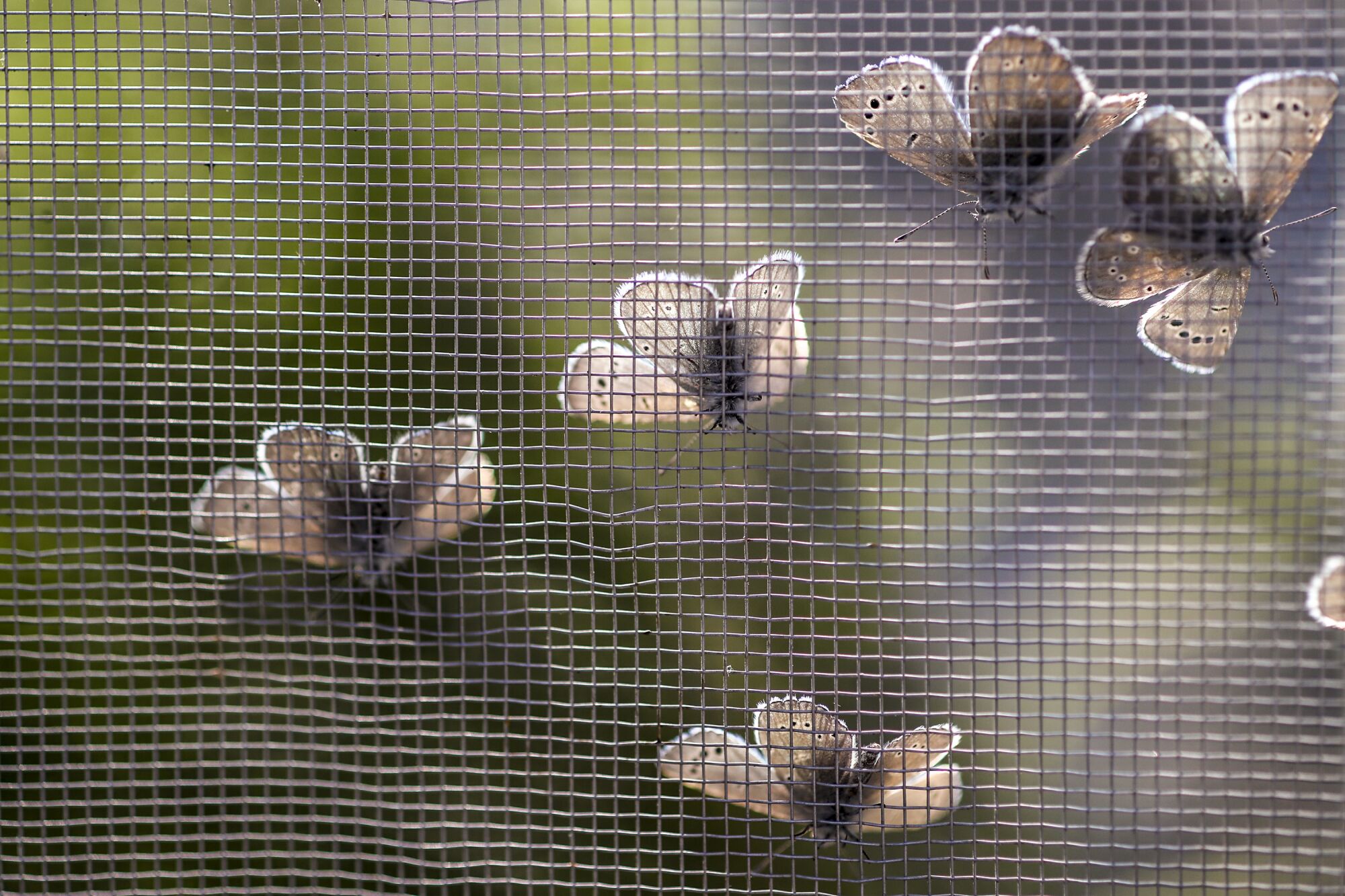
Palos Verdes blue butterflies cling to the screen of their “honeymoon suite” cage, showing off the dull beige undersides of their wings.
(Robert Gauthier / Los Angeles Times)
A miraculous survival
The Palos Verdes blue butterfly is so small and so blue — the kind of deep sky-blue that makes people exclaim, “What a beautiful day!” — that it looks more like jewelry than a living creature.
But when Johnson started her work with the butterflies, it was money more than beauty that attracted her.
Her research was going nowhere, largely because she couldn’t find enough lizards to study. Her work as a teaching assistant for professors at UCLA brought in little money, and on New Year’s Day 2004, her husband left. Their eldest son, Max, was 4; Sam was 20 months.
So initially, her new job as an assistant to noted lepidopterist and UCLA professor Rudi Mattoni was just an additional source of needed income. Her duties? To help preserve the small, last-known colony of blues that Mattoni had discovered in San Pedro in 1994.
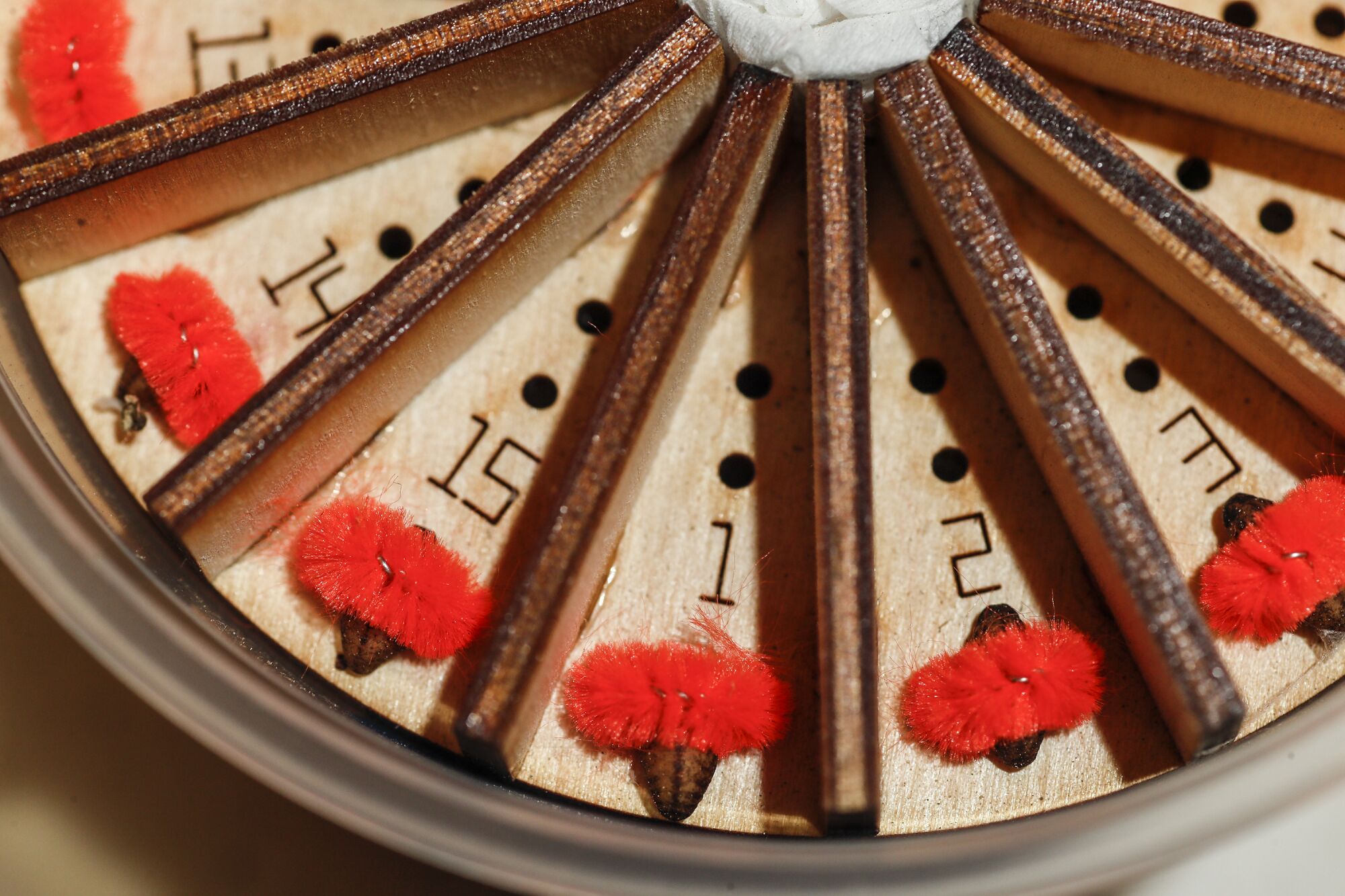
Palos Verdes blue butterfly pupae are snuggled under pipe cleaners and cataloged as they grow at America’s Teaching Zoo at Moorpark College.
(Robert Gauthier / Los Angeles Times)
That Mattoni found the PV blues 11 years after they had been declared extinct seems miraculous, given all the impediments to their survival.
Their range had historically been limited to the Palos Verdes Peninsula, a fist of land jutting into the Pacific Ocean between Redondo Beach and Long Beach, mostly covered now with houses, highways, shopping centers, an oil refinery, a military installation and acres of manicured turf, leaving only a few small pockets of undeveloped coastal scrub habitat.
This is the first problem, since adult butterflies survive only about a week in the wild, said Johnson. During that time, they have to find one or more sex partners and a suitable plant on which to lay eggs.
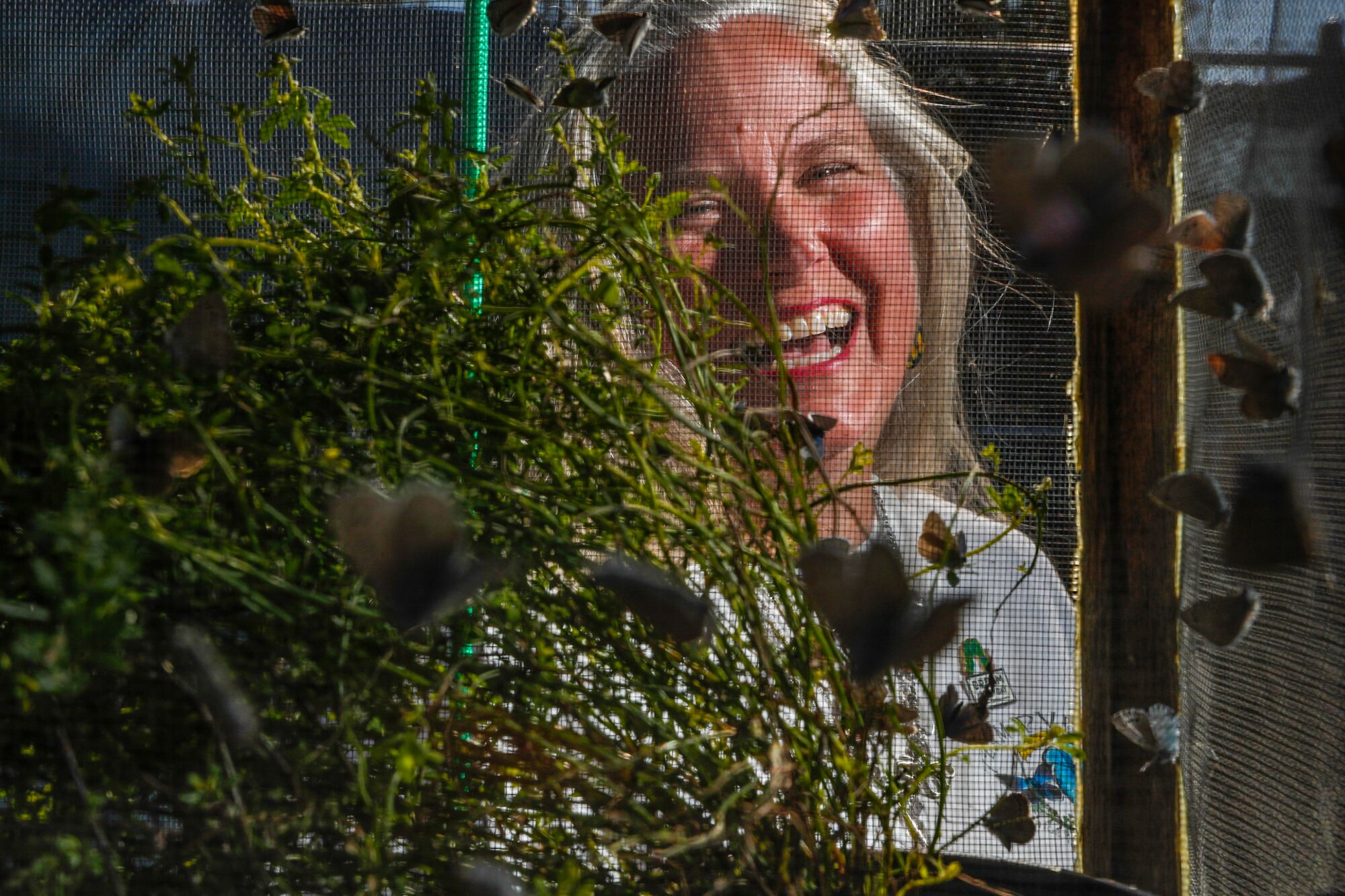
Jana Johnson beside a habitat full of Palos Verdes blue butterflies. At Moorpark College, she and students nurture the butterflies for releases into the wild.
(Robert Gauthier / Los Angeles Times)
Like many butterflies, the larvae of PV blues require very specific native plants — deerweed (Lotus scoparius), a short-lived shrub with yellow flowers, and Santa Barbara milk vetch (Astragalus trichopodus), a member of the pea family whose pinkish-white flowers turn into large pods filled with seeds.
That specificity poses a problem: Deerweed and milk vetch are disturbance plants, which means they require some kind of soil disturbance — like fire — to sprout and outgrow the other plants around them.
Fire, once common, is not an option today, so the Palos Verdes Peninsula Land Conservancy brings in goats to disturb the soil by trampling and eating fast-growing invasives like mustard.
Ironically, another form of disturbance is bulldozing, which doesn’t seem a great option, except in the case of the Defense Fuel Support Point in San Pedro, created by the Navy in 1943 to provide secure fuel storage sites.
The site was long closed to the public and subject to periodic bulldozing to keep down weeds, explained Travis Longcore, science director for the Urban Wildlands Group. That isolation and regular disturbance was keeping a tiny colony of PV blues alive when Mattoni and entomologist Rick Rogers found them on March 12, 1994, while doing a routine survey of peninsula insects funded by Longcore’s organization.
“We were walking very close together, maybe five paces apart, and I was the first to see the butterfly,” Rogers recalled. “I said, ‘Rudi, look at that! There’s a blue.’”
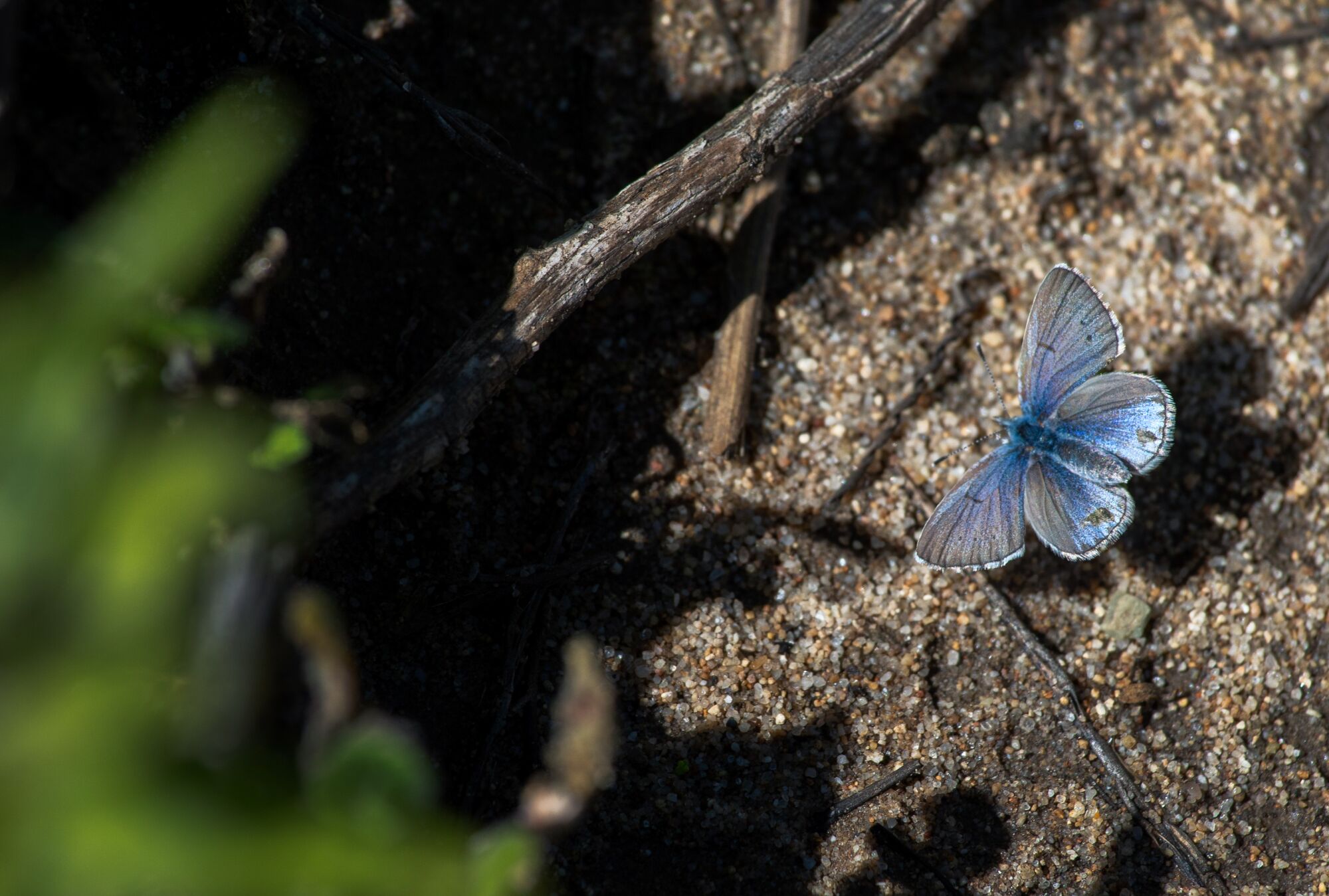
A Palos Verdes blue butterfly newly released into the wild.
(Brian van der Brug / Los Angeles Times)
“I didn’t know it was the blue … and even Rudi had to catch it before he was certain. But then he looked at me and gave out a shout. ‘We just got the jackpot! We won the lottery! Do you know what this is, kiddo? (He always said ‘kiddo’) This is the Palos Verdes blue butterfly and he is alive right here!’”
Mattoni, 94, died in January of 2022, but Longcore kept records of the find. The surveyors found about half a dozen blues that day, he said. Using a formula for counting butterflies, they calculated there were likely 69 Palos Verdes blue butterflies on the site — the only remaining population in the world.
Federal officials gave Mattoni permission to collect a few of the remaining blues for a captive rearing program in San Pedro, which became known as the Butterfly Project.
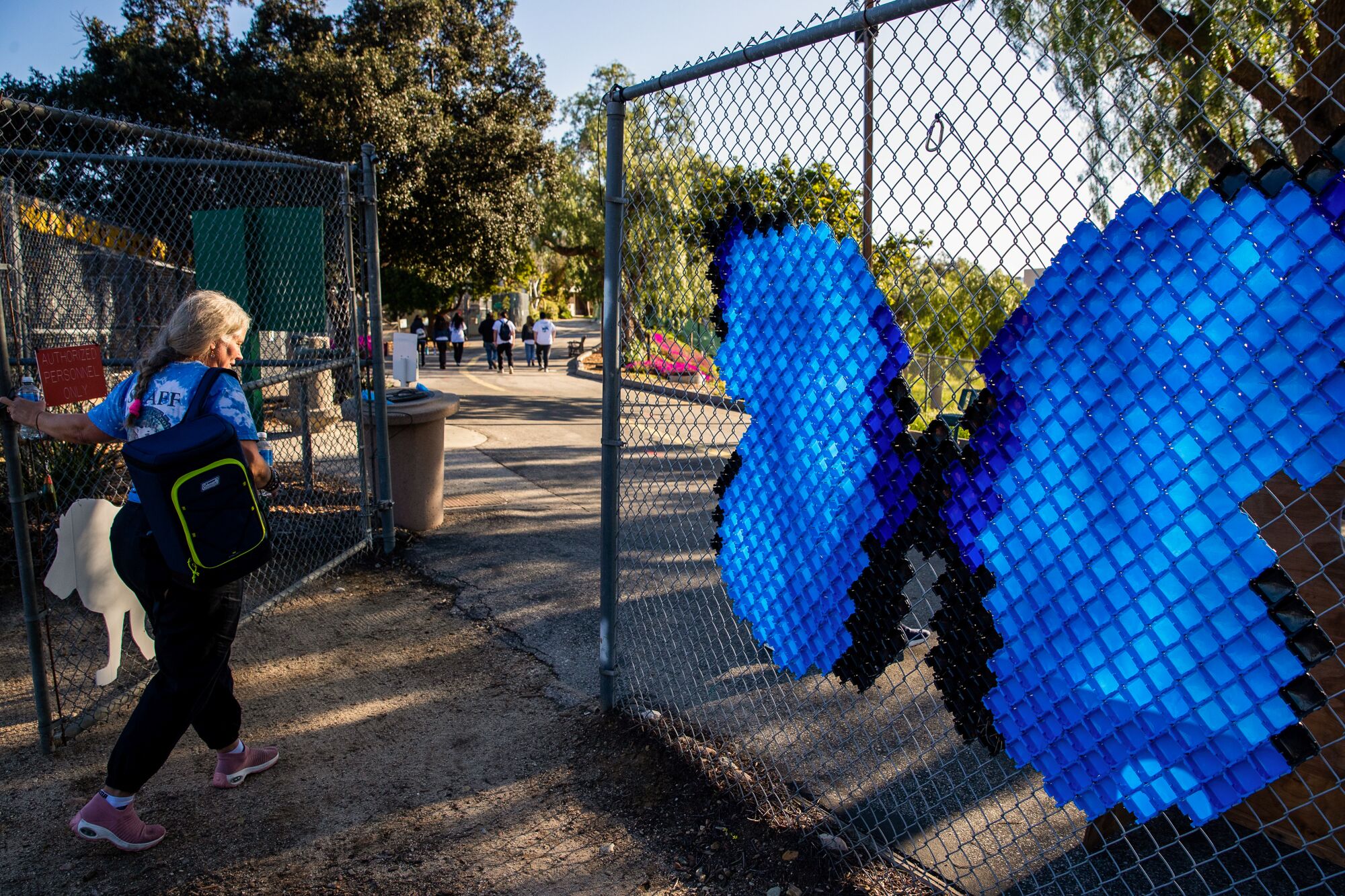
The Butterfly Project at America’s Teaching Zoo at Moorpark College is surrounded by a tall, colorfully decorated fence.
(Brian van der Brug / Los Angeles Times)
Charting a new course, despite fears
It was nine years later that Johnson took a job as Mattoni’s assistant. Despite early indifference and personal upheaval, she soon got hooked on the PV blues.
She was in awe of Mattoni’s butterfly expertise — “He knew more about butterflies than I ever will” — but after a few years, his protocols for handling the insects troubled her: The captives’ only food came from the plants in their cages, and when ants killed many of the adults, Mattoni was adamant they couldn’t intervene.
He saw the interactions between ants and butterflies as a kind of symbiotic circle of life, she said.
The ants would groom and defend the caterpillars because they exuded a sugar-water the ants liked to eat, but when the butterflies emerged from their chrysalises, “I watched the ants crawl in and butcher the butterflies, just cut them up for food to take home, and I was like, ‘So we’re just raising them as cattle?’”
Johnson reasoned that the blues needed help to multiply. After three years working with Mattoni, she got permission from the project funders to try her own protocols on a small group: She kept ants away from the cages and in addition to providing the plants, she began hand-feeding 18 females with locally sourced honey water.
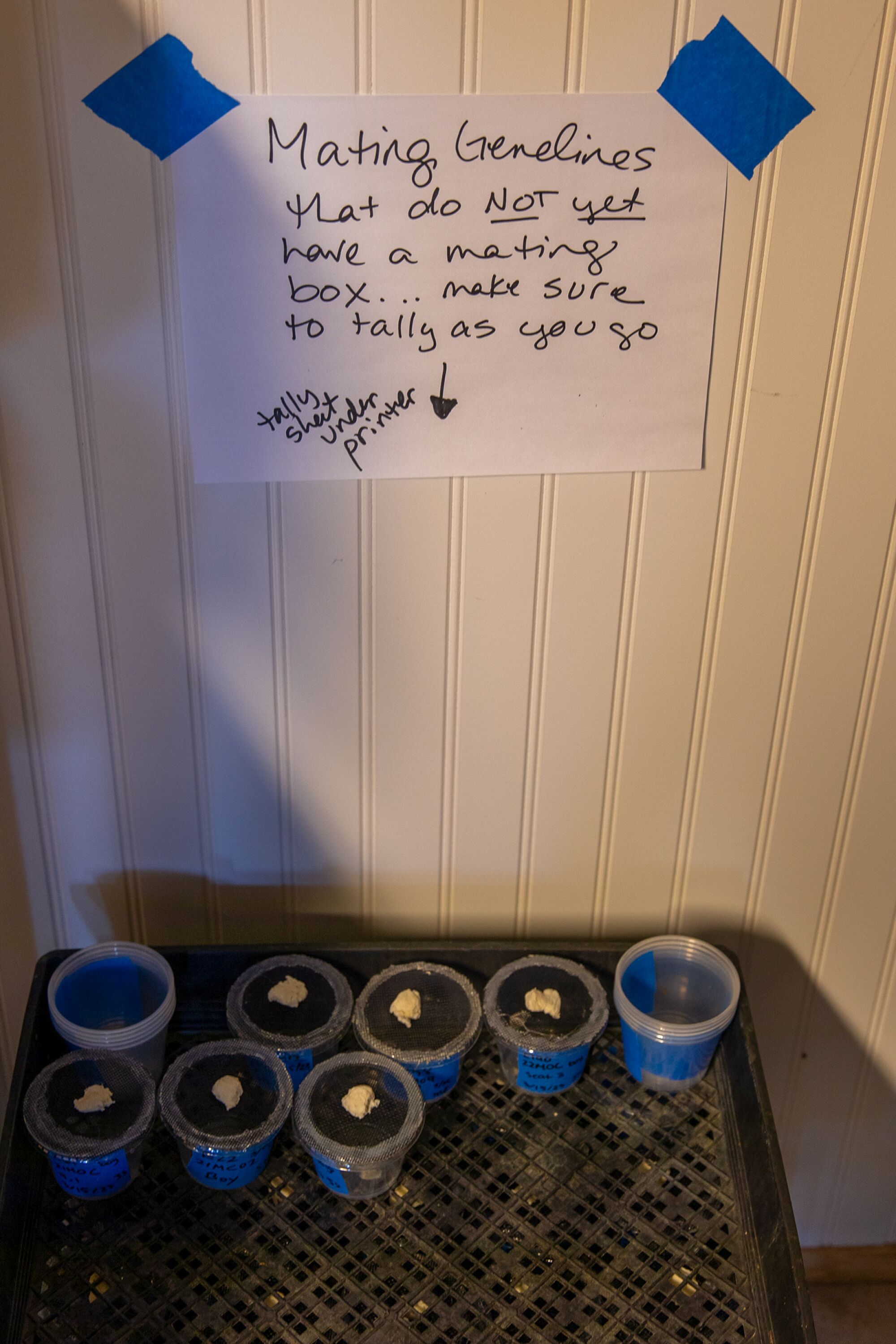
Plastic cups with screen-topped lids hold Palos Verdes blues waiting for release.
(Brian van der Brug / Los Angeles Times)
Under Mattoni’s protocols, the butterflies had been producing about 200 pupae each year, Johnson said. At the end of her first season in 2006, the number jumped to nearly 750.
Longcore supported Johnson’s technique from then on.
“If it were not for her inspiration to rear the butterflies a different way and her ability to motivate and engage a team of people to make this rearing program successful, I would put my money on us having lost the species,” he said.
Johnson recoils from taking credit. Without other members of the team, she said, like the Palos Verdes Peninsula Land Conservancy and the U.S. Navy, there wouldn’t be any habitat where the blues could survive in the wild.
Johnson grew up in Austin, Texas. Her father was a campus pastor, and her science-inclined mother stayed at home to raise her and her two sisters and nurture their curiosity about the world.
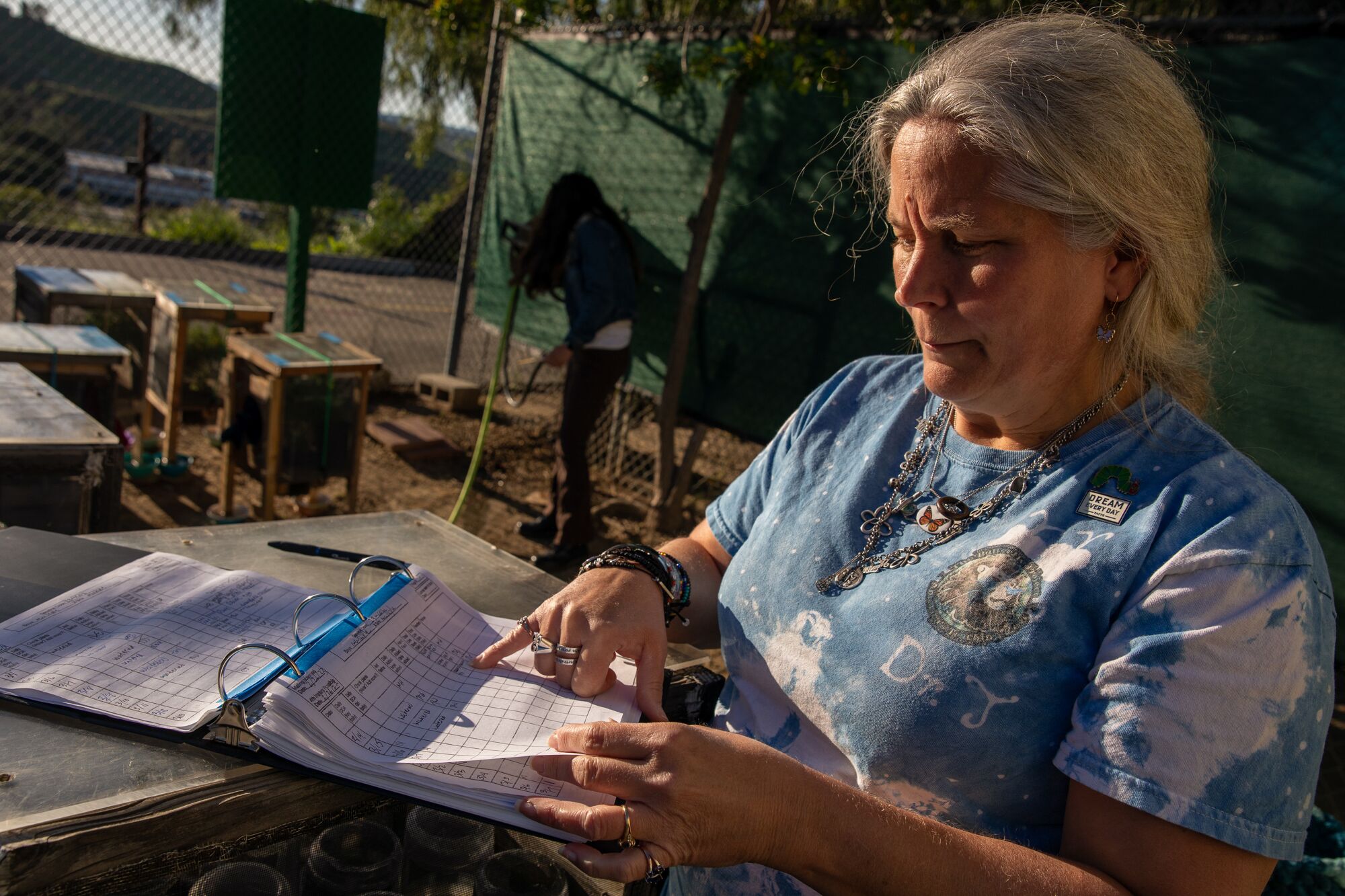
Record keeping is a critical part of Jana Johnson’s butterfly rearing work.
(Brian van der Brug / Los Angeles Times)
“We were kind of feral children,” she said, describing long days exploring the creek and critters near their home.
Johnson’s love for nature fueled her first two biology degrees, and in 1996, she and her then-husband moved to L.A. He wanted to become an actor, and she began her challenging lizard research at UCLA.
Her rocky progress was made worse by two unsupportive advisors — one of whom called her after her second son’s birth and said, “You have no business seeking education nor employment. It is your duty to stay home and raise those boys.”
Johnson, now 54, is tall, with long, silvery blond hair and astonishing greenish blue eyes that change color with her mood. She looks like a cross between the quintessential earth mother and a Viking goddess, but when she talks about the tug between caring for her children, supporting her family and pursuing her passion, her eyes go dark with tears.
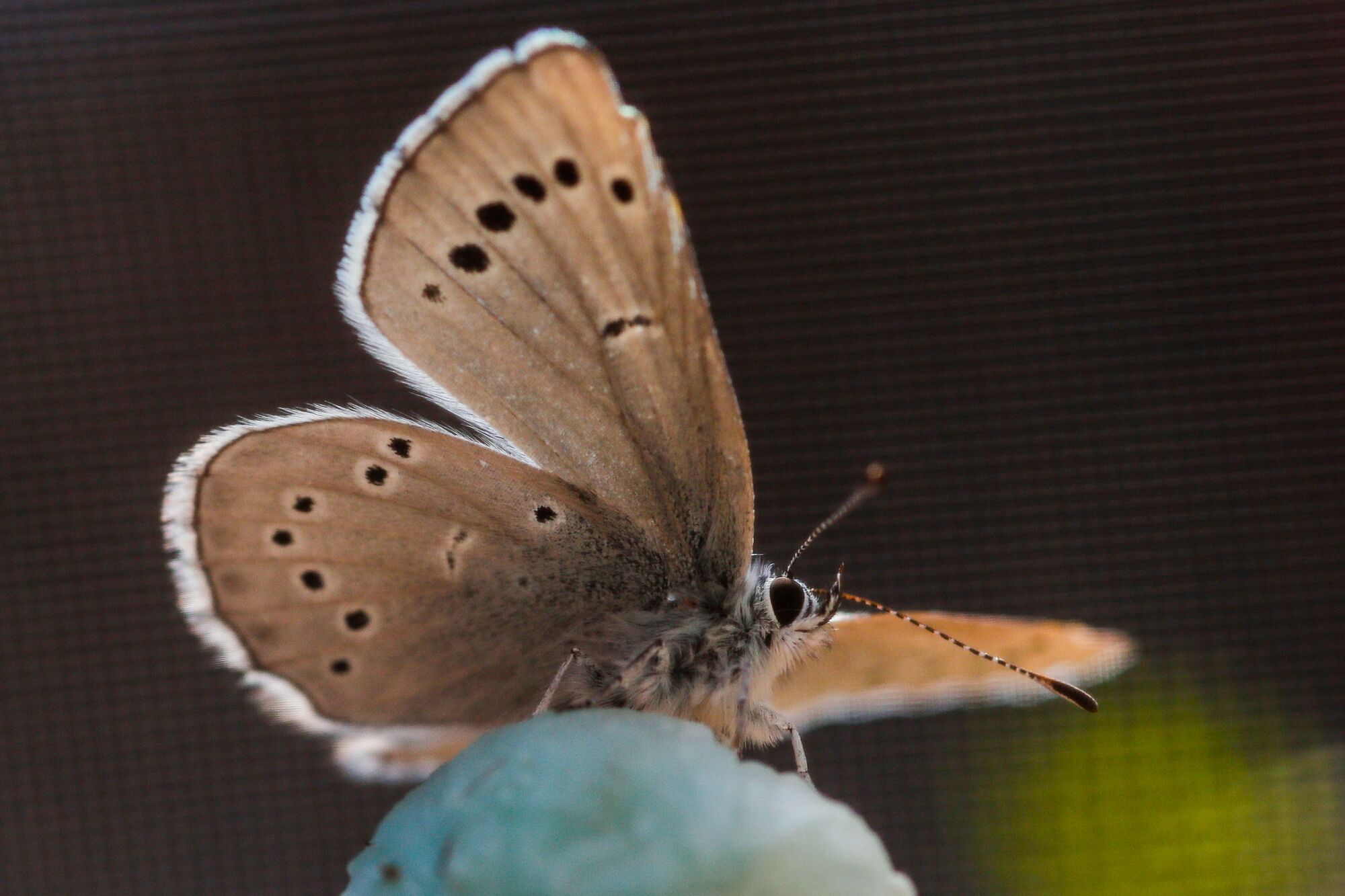
The drab undersides of Palos Verdes blue butterflies helps protect them from predators.
(Robert Gauthier / Los Angeles Times)
Hurting your children while you pursue your career is the worst nightmare of many working mothers, but during a butterfly release session earlier this spring, her son Max laughed at the suggestion that he and his little brother played second fiddle to a rare butterfly.
“Our family vacations were usually work trips for her. She’d work in the field, and we’d follow her looking at bugs and birds and lizards and stuff,” he said. “We loved it. At no point was there ever any animosity towards this project. And being with a mom so passionate about something gave us an incredible work ethic. We just liked being around her.”
Sam just finished his junior year at Loyola Marymount University, studying finance, and Max just graduated from Pepperdine University with degrees in biology and history, so Johnson said she’s been sending thank yous to the people who helped raise her boys to college-age men.
“I’m writing to friends who helped teach my son to read and invited us over for the holidays when we had nowhere to go,” she said. “And to my fellow moms, friends to this day, who would leave Ralphs cards on my doorstep so I could buy groceries and ask if I’d heard of LA84, where your kids can do sports for free during the summer … what a godsend was that program.”
And on Fridays, friends always dragged them to the beach, she said. “That’s where I finally realized that L.A. was my home, my safety net was my friends and it’s always necessary to have a team, whether you need help rearing butterflies or buying groceries.”
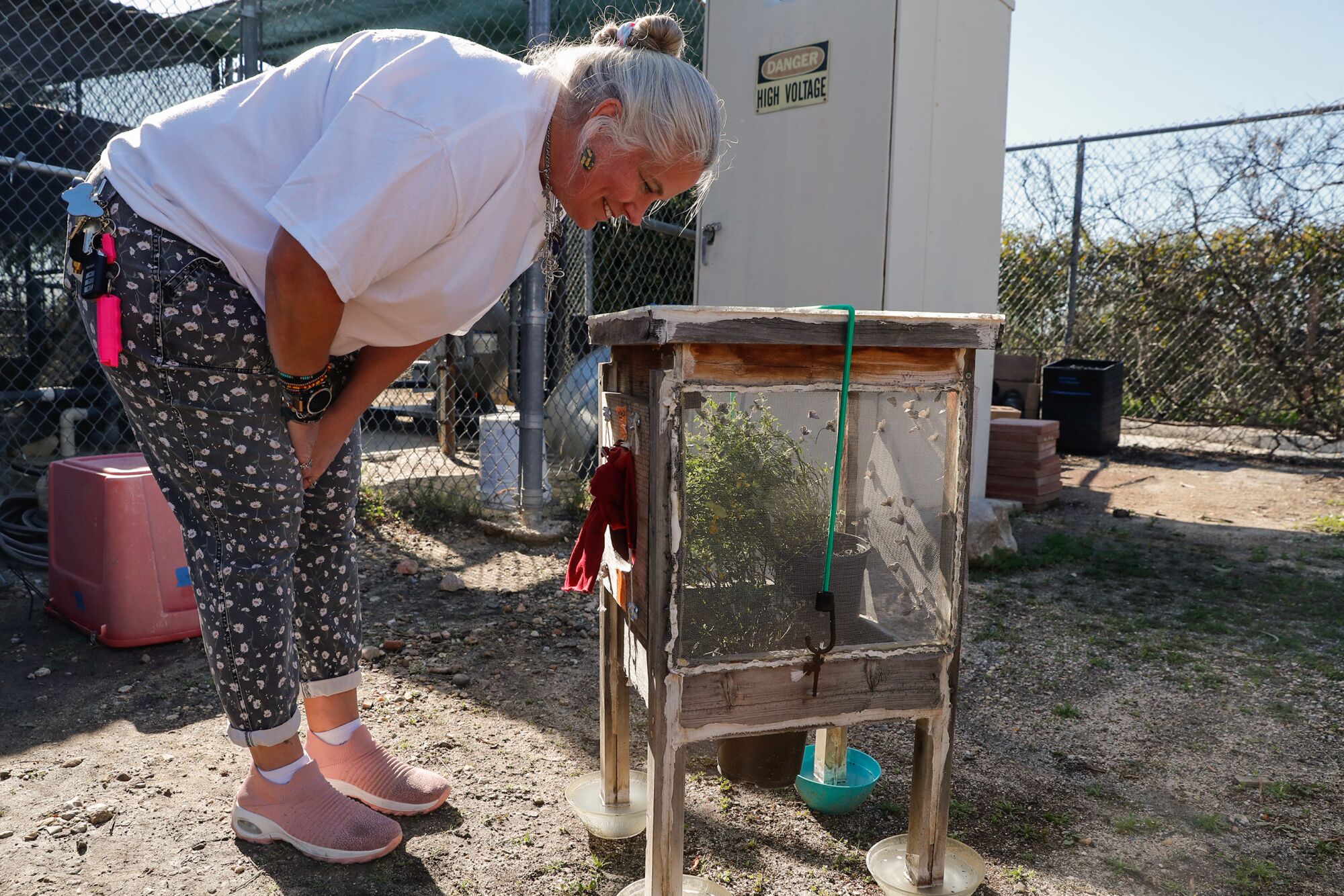
Jana Johnson peers inside a rustic “honeymoon suite” cage, which allows captive butterflies to mate and lay their eggs on the deerweed plant inside.
(Robert Gauthier / Los Angeles Times)
Butterfly rearing between a lion and tigers
By the time Johnson took over the Butterfly Project in 2006, saving the PV blues had become her new dissertation — the one that would earn her a PhD in 2008.
But her protocol for raising the butterflies was labor intensive, she had no helpers, and she spent hours driving from her San Fernando Valley home to work at UCLA and rear butterflies in San Pedro.
“I was stressing out,” she said.
Once again, a friend came to her rescue.
“She said, ‘We need to take the kids to the zoo,’ and she brought us to Moorpark Zoo, which I didn’t even know existed.”
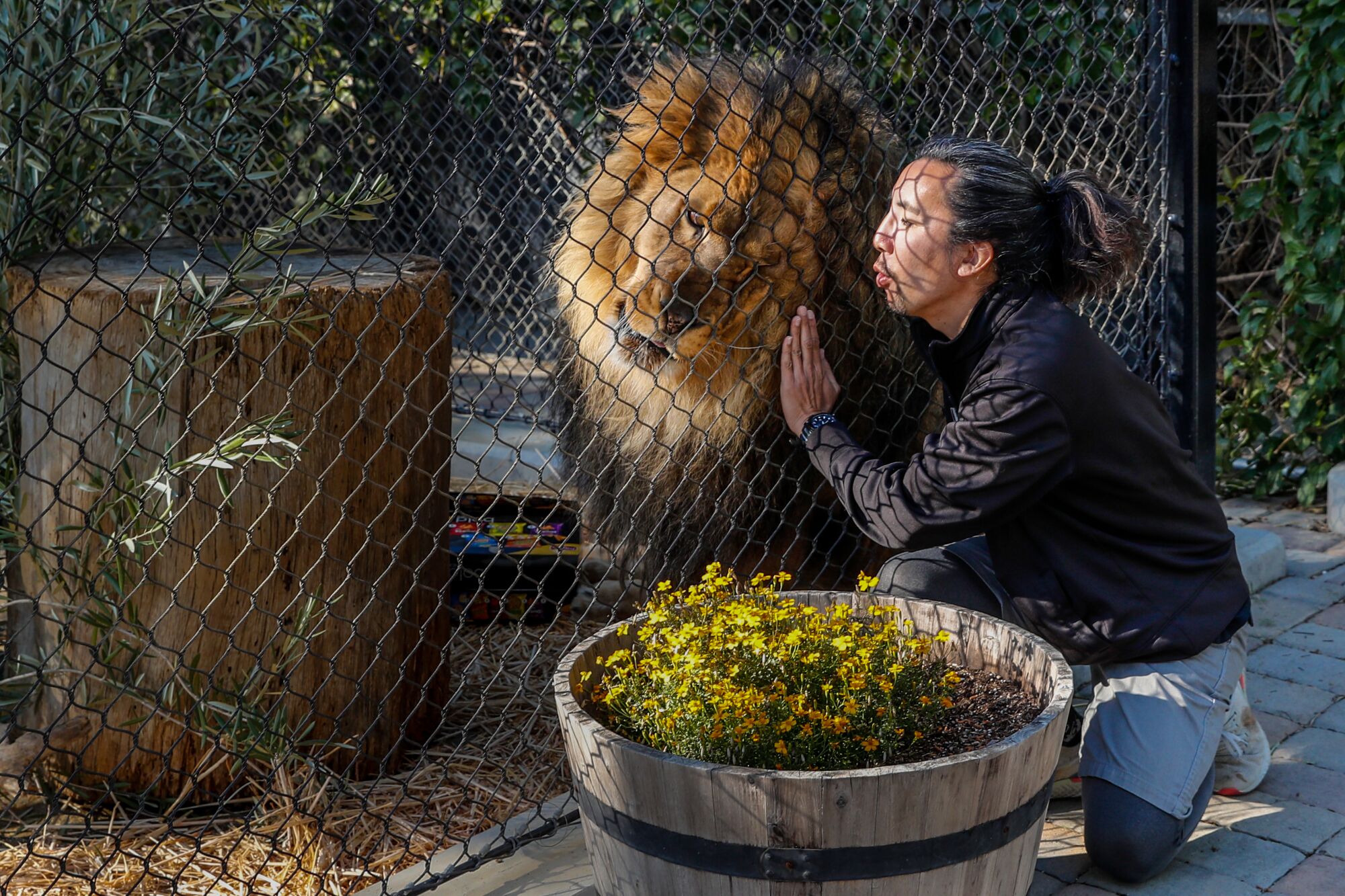
Taiki Yoshid, America’s Teaching Zoo operations assistant, greets Ira the lion, whose enclosure is near the Butterfly Project at Moorpark College.
(Robert Gauthier / Los Angeles Times)
America’s Teaching Zoo at Moorpark College is a small facility in east Ventura County with more than 90 species, including birds, baboons and big cats, but Johnson wasn’t focused on the animals.
“We were walking down the front road with our kids, and all the while I’m thinking, ‘This is a college campus. I can teach here. And I can set up an endangered-butterfly rearing facility at their zoo!’”
That’s how it worked. She got a summer job teaching anatomy at Moorpark College in 2006 (where she’s now a tenured biology professor) and almost immediately asked the zoo director for space to rear the blues, using students as assistants.
“Let’s find you a space,” he said, and between the lion and tigers, the new Butterfly Project was born.
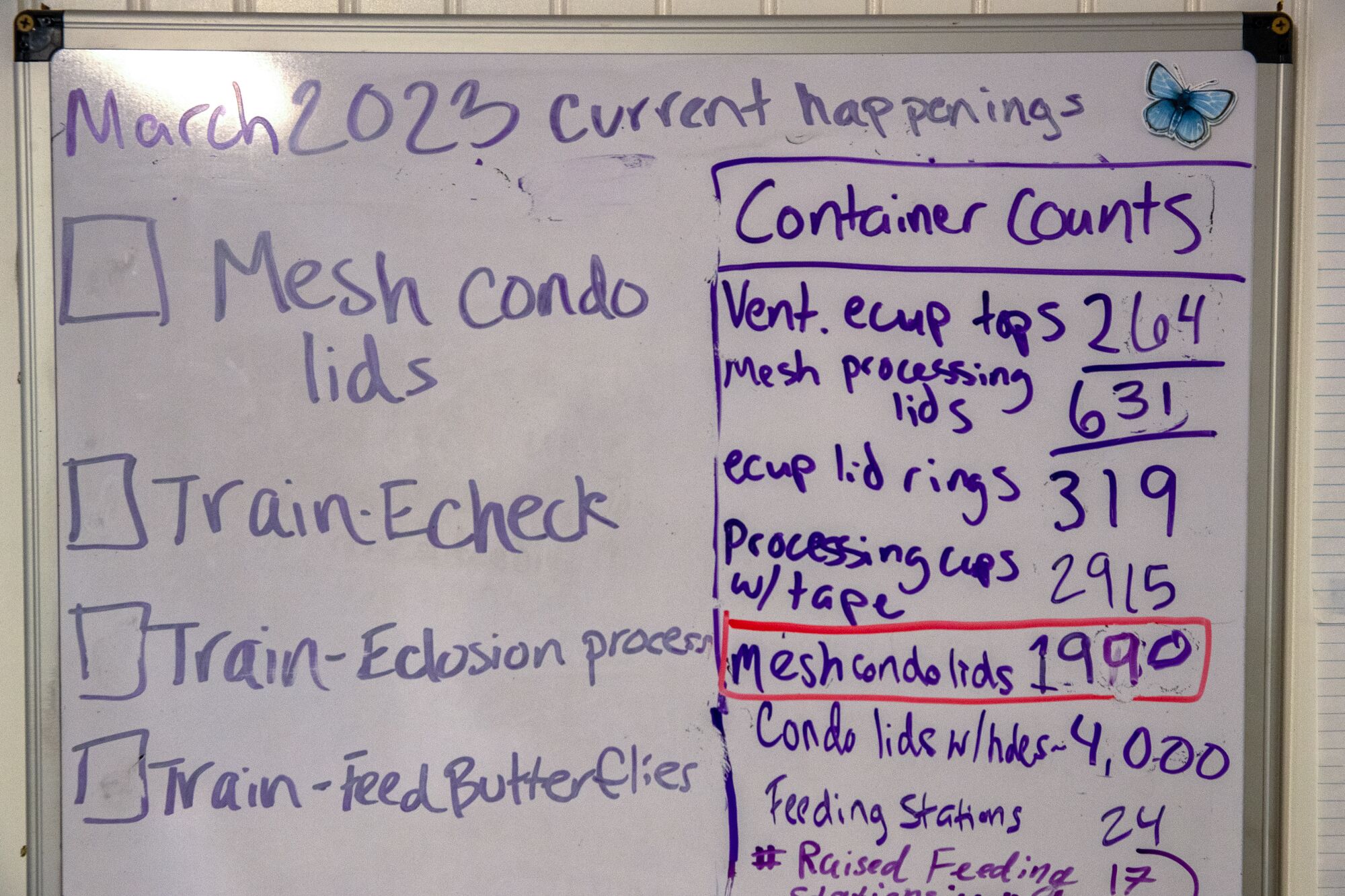
A to-do list at Jana Johnson’s butterfly enclosure at Moorpark College.
(Brian van der Brug / Los Angeles Times)
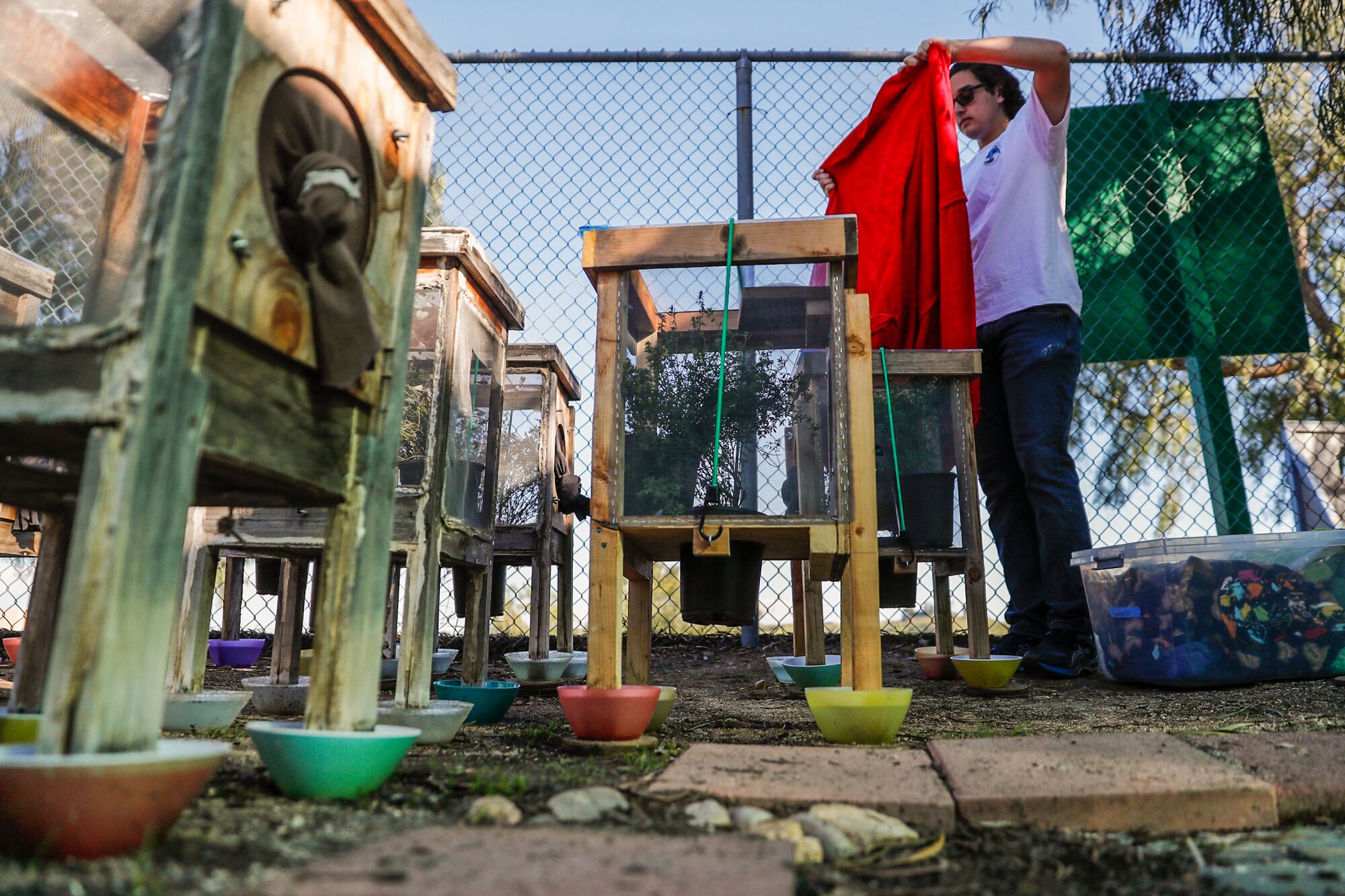
David Torres, a student intern for the Butterfly Project, covers the cages with a blanket to project them from nighttime chills. Bowls of soapy water prevent ants from invading the outdoor structures.
(Robert Gauthier / Los Angeles Times)
The first year she recruited 18 students to work on the project. They built “honeymoon suites,” rustic wood boxes with screened-in lids and sides that stand on four tall legs. To deter ants, each leg was moated in a cereal bowl filled with soapy water. When the butterflies emerged, the students added balls of toilet paper soaked in honey water to their cages, in addition to deerweed, so they’d have plenty of energy to mate and lay eggs.
They ended the 2007 season with more than 4,500 pupae, enough that Johnson dared ask for permission to try her first release of captive-reared butterflies the following spring — 459 pregnant PV blues and more than 3,000 caterpillars nearly ready to pupate placed into a habitat on the peninsula restored by the Palos Verdes Peninsula Land Conservancy.
There were naysayers, of course, who said the captive butterflies wouldn’t survive in the wild or be able to find each other to mate. But for the last several years, surveyors have found PV blues in the wild before new releases.
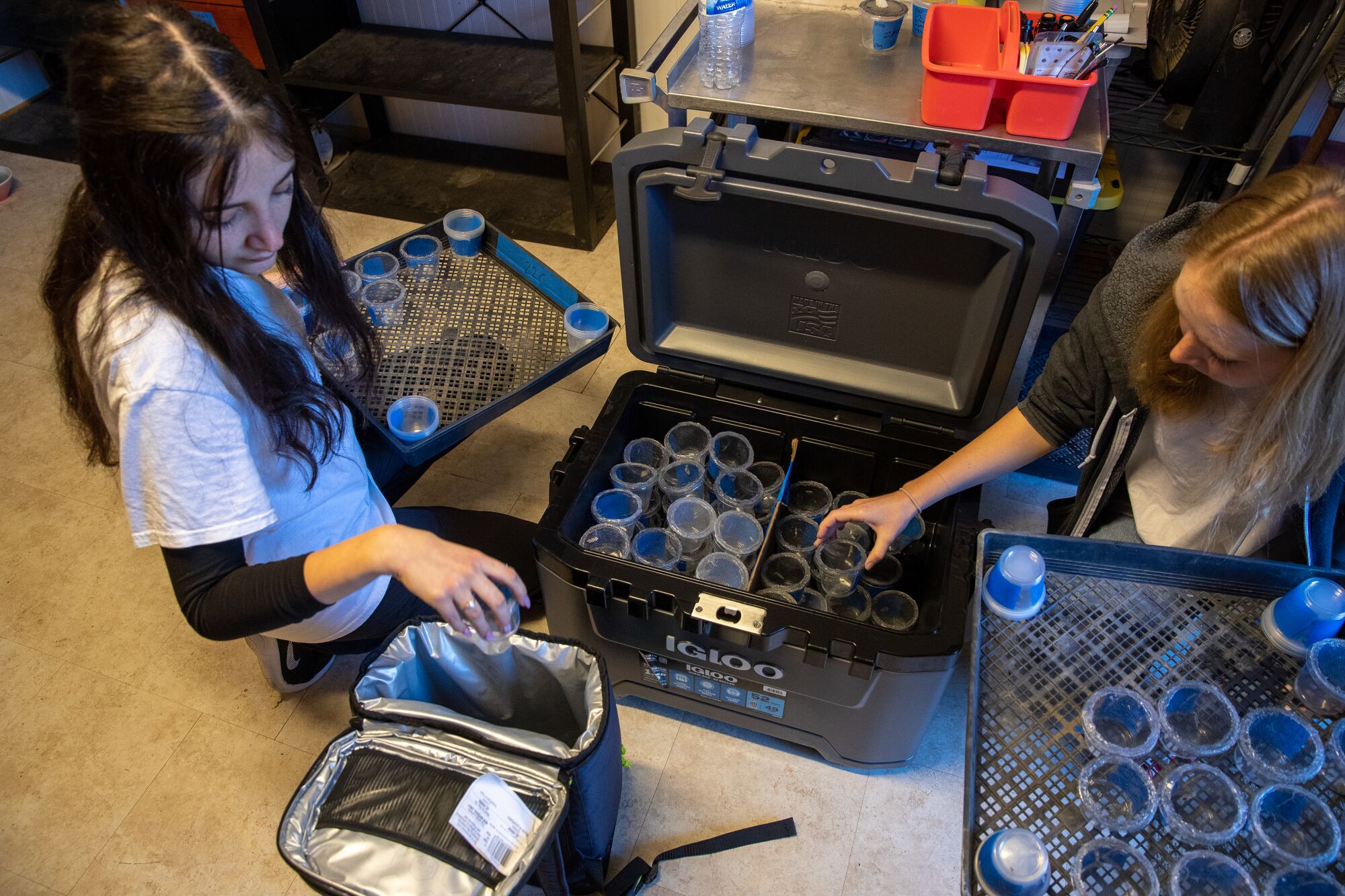
Moorpark College student Thea Zlatov, 19, left, and Morgan Hickey, 18, load endangered Palos Verdes blue butterflies for transport to a release area in the wild.
(Brian van der Brug / Los Angeles Times)
As for the captive butterflies mating in the wild? During their four butterfly releases this spring, Johnson’s helpers quickly spotted — and photographed — multiple mating couples clinging to deerweed.
All told, Johnson figures she’s released more than 5,000 blues into the wild since 2008, and more than 12,000 caterpillars.
The actual number of released butterflies isn’t his main concern, Longcore said.
“The more important piece is we have four different places where they are established now, instead of one. The only road to recovery is getting this butterfly back into its historic range, so every time we establish a new population, we reduce their extinction risk.”
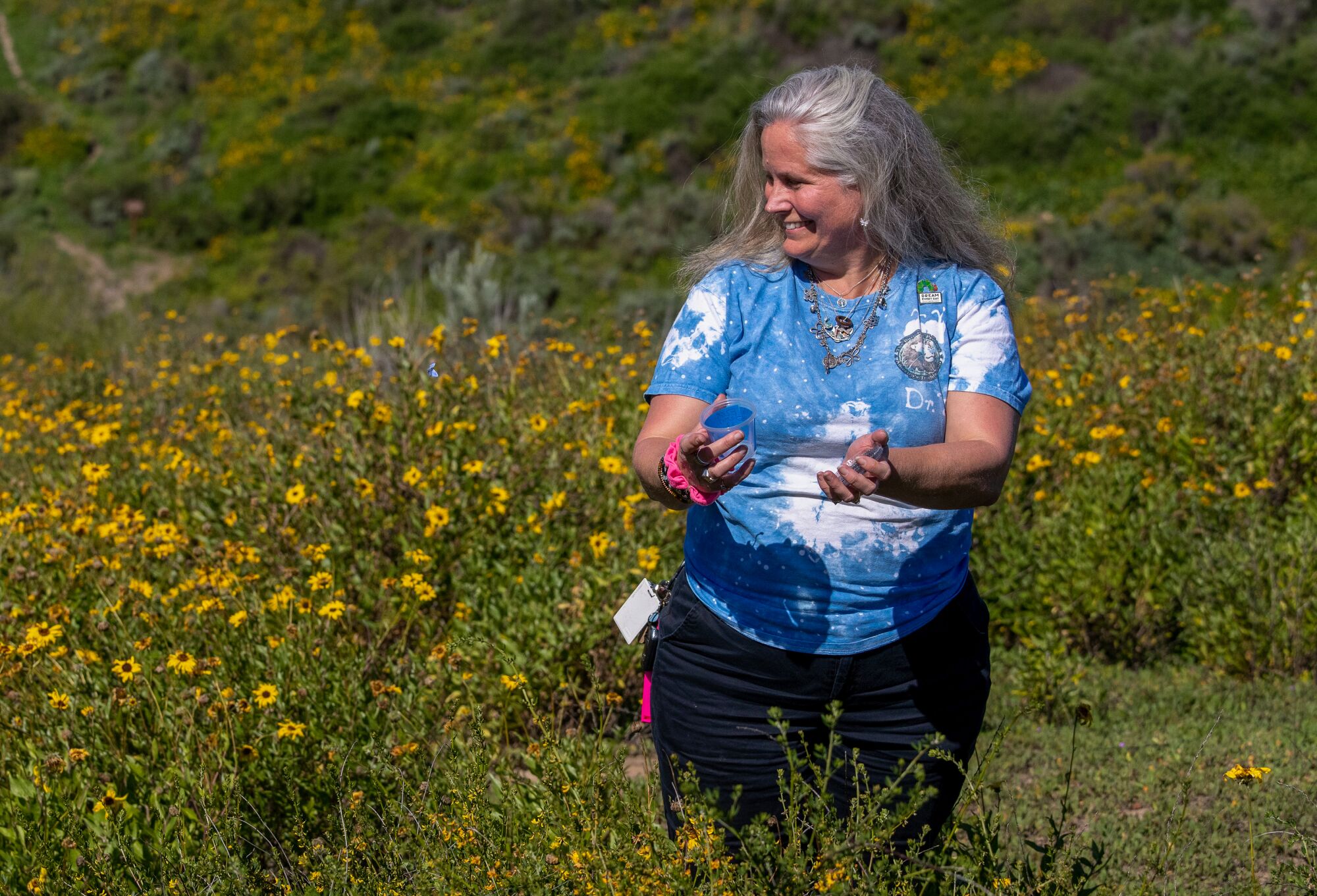
Jana Johnson is all smiles as she watches one of her “babies” fly into the wild during a blue butterfly release on the Palos Verdes Peninsula in April.
(Brian van der Brug / Los Angeles Times)
Letting her ‘babies’ fly
At the final butterfly release of this year, Johnson looked both exhilarated and tired as she briefly laid out the rules for her volunteers, like how to open the screen-topped holding cups so the butterflies weren’t accidentally squished in their rush to freedom. She reminded the workers to never mention the locations to protect the rare species from poachers.
The releases happened quickly, punctuated by gleeful shouts when the butterflies found a mating partner. “My babies,” Johnson joked fondly, and then got wistful talking about Max’s graduation.
The last two decades have been mostly about others — her children, her students and the PV blues. It might be nice to take some time off to travel, she acknowledged, maybe go on a date …. she laughed.
But stopping her work to save an obscure, nearly extinct butterfly isn’t an option, she said, because biodiversity is how we’ll save the world.
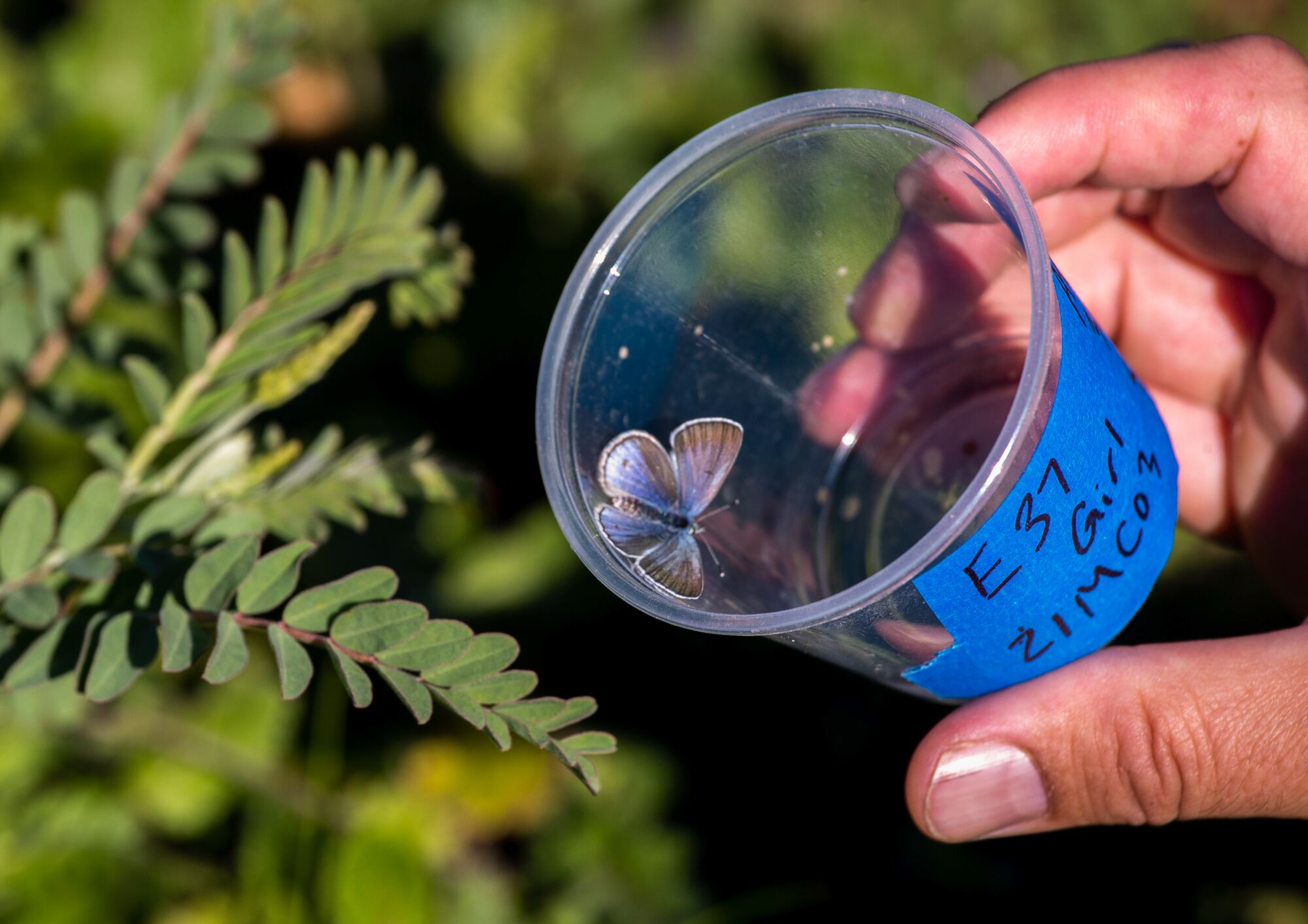
A female Palos Verdes blue lingers on its cup, basking in the sun. The blues typically survive about seven days in the wild, during which time they must find a mate and the right plant on which to lay their eggs.
(Brian van der Brug / Los Angeles Times)
“Earth is our spaceship, and all its species are the rivets holding the ship together. So how many rivets can you pop out? Can you pop out one? Sure. Can you pop out two? Well, probably. But how many can you pop out before the spaceship doesn’t work anymore?”
The blues are her rivet, Johnson said, as her eyes changed color, dark blue and fierce.
“People look at me and say, ‘You’re so crunchy granola. You’re such a tree hugger,’ but this is very much about humans. I love my sons, and someday I’ll love my grandkids. I want them to live on a healthy planet, and that’s why I’m holding my rivet in.”
This story originally appeared on LA Times

